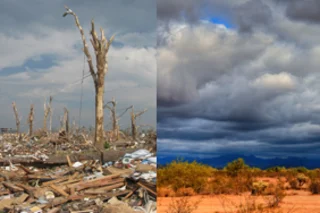On May 21, 2011, a tornado ripped through Joplin, Mo. (Credit: Melissa Brandes/Shutterstock). A storm brews somewhere over the American Southwest (Credit: Paul B. Moore/Shutterstock). Associating natural disasters with climate change -- like some did last week with the massive tornado that touched down in Oklahoma -- is a distortion that has been rattling around for nearly a decade or longer. The most glaring example may be Al Gore’s portrayal of Hurricane Katrina in his 2006 film An Inconvenient Truth. According to Gore, the hurricane was the outcome of unchecked anthropogenic greenhouse gas emissions and a harbinger of what’s to come. But he was quickly called out for misrepresenting the science to gain support for his cause. And as the dust settled in Oklahoma, it became clear that 1) the situation sucked, and 2) the science is still out on whether or not there is a concrete connection between global ...
A Deluge of Uncertainty About Natural Disasters and Climate Change
Explore the connection between climate change and tornadoes, and the impact of global warming on extreme weather events.
More on Discover
Stay Curious
SubscribeTo The Magazine
Save up to 40% off the cover price when you subscribe to Discover magazine.
Subscribe













